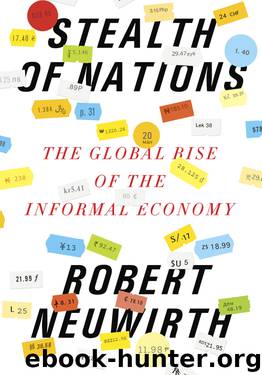Stealth of Nations by Robert Neuwirth

Author:Robert Neuwirth [Neuwirth, Robert]
Language: eng
Format: epub
Tags: Economics, Entrepreneurship
ISBN: 978-0-307-90680-9
Publisher: Knopf Doubleday Publishing Group
Published: 2011-10-18T02:00:00+00:00
Over the past decade, Social Compact, a nonprofit based in Washington, D.C., has been studying the size of the System D in the United States. In a series of studies, the group has shown that “unregulated economic activity” represents a significant amount of wealth, particularly in poorer communities around the country. In central Miami, for instance, this sub-rosa resource represents $850 million in undeclared income. In Baltimore, it’s $872 million. In just one New York neighborhood—Harlem—it’s $800 million. The District of Columbia, the nation’s capital, boasts a robust alternative system that produces $1 billion of income for the people who rely on it. Houston, too, has $1 billion in System D trade. And a 2005 study by the Los Angeles Economy Project estimated that System D in the environs of the City of Angels involves almost seven hundred thousand jobs that together produce $8.1 billion in wages a year. In percentage terms, the United States may have one of the smallest shadow economies in the world—Friedrich Schneider, the Austrian economist who makes it his business to evaluate informality, puts it at somewhere between 8 and 9 percent of the gross domestic product—but, given the size of the U.S. economy, America is a System D superpower, with the largest unregistered economy in the world, worth more than $1 trillion.
Alfonso Morales, a professor of urban and regional planning at the University of Wisconsin, is perhaps one of the few academics who writes about System D who has actually experienced it from the inside. That’s because he put himself through graduate school in part by selling closeout hardware on Maxwell Street in Chicago. Indeed, his experience in the market became the subject of his thesis.
The Maxwell Street Market has been a big part of the Second City’s life since the 1870s. The market was municipally managed for the first century of its existence. After the urban disturbances of the 1960s, the city basically abandoned its managerial role, and Maxwell Street was run as an informal cooperative of merchants for the next twenty years. In 1994, the city forced the market to relocate and wrested back control. During that transitional period, Morales sold at the market every Sunday for a year and a half—changing stalls five times so he could experience and understand the reality of vendors who come and go, and the way long-term merchants treated new arrivals. And he returned almost every week for two years thereafter to continue his research. He found that vendors shared responsibilities—holding slots for one another, letting newcomers know the unwritten rules, policing the market. Each time he moved his booth, he wrote in a recent essay, he had to spend time establishing ties with his new neighbors. “I tested both sides of these relationships—as the interloper, finding vendors vigorously defending their neighbor’s space as well as their own, and as the neighboring vendor, expected to play a role in preserving space,” he said. Morales saw how tables were allocated through a customary arrangement, how people decided
Download
This site does not store any files on its server. We only index and link to content provided by other sites. Please contact the content providers to delete copyright contents if any and email us, we'll remove relevant links or contents immediately.
| Anthropology | Archaeology |
| Philosophy | Politics & Government |
| Social Sciences | Sociology |
| Women's Studies |
The Secret History by Donna Tartt(18188)
The Social Justice Warrior Handbook by Lisa De Pasquale(11957)
Thirteen Reasons Why by Jay Asher(8461)
This Is How You Lose Her by Junot Diaz(6451)
Weapons of Math Destruction by Cathy O'Neil(5842)
Zero to One by Peter Thiel(5498)
Beartown by Fredrik Backman(5369)
The Myth of the Strong Leader by Archie Brown(5243)
The Fire Next Time by James Baldwin(5024)
How Democracies Die by Steven Levitsky & Daniel Ziblatt(4966)
Promise Me, Dad by Joe Biden(4911)
Stone's Rules by Roger Stone(4866)
100 Deadly Skills by Clint Emerson(4695)
A Higher Loyalty: Truth, Lies, and Leadership by James Comey(4556)
Rise and Kill First by Ronen Bergman(4548)
Secrecy World by Jake Bernstein(4393)
The David Icke Guide to the Global Conspiracy (and how to end it) by David Icke(4386)
The Farm by Tom Rob Smith(4329)
The Doomsday Machine by Daniel Ellsberg(4250)
